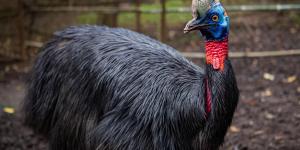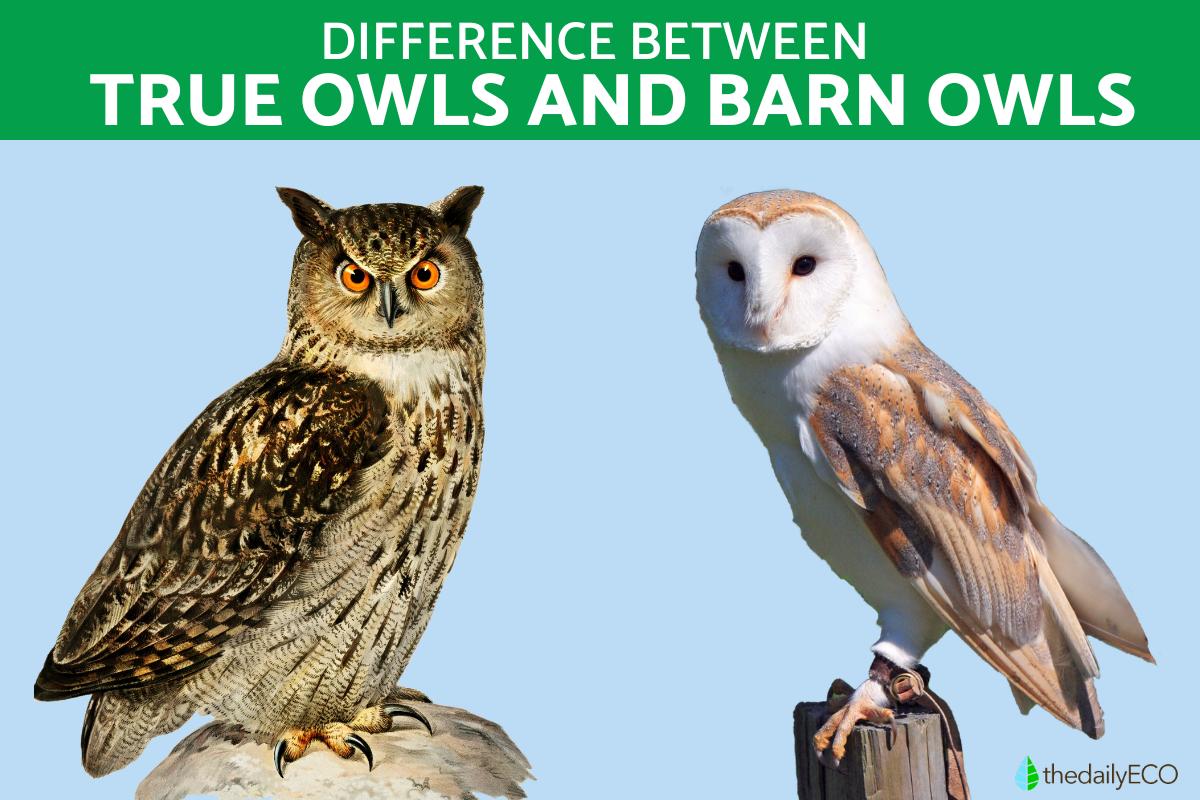Difference Between True Owls and Barn Owls


Owls and barn owls are probably the best known nocturnal birds of prey in any corner of the planet. Although they share many similarities and sometimes even the same habitats, these birds of prey have many differences from each other. Would you know how to differentiate an owl from an owl with the naked eye? On many occasions, both birds are called owl or owl interchangeably, as in the case of the famous "owl" that accompanies Harry Potter, did you know that it is actually an owl?
If you want to know more curious facts about the differences between owls and barn owls, continue reading this interesting EcologíaVerde article in which you will discover in detail the difference between an owl and an owl .
What are the differences between true owls and barn owls?
True owls, scientifically known as the family Strigidae, encompass a wide range of owl species found across various habitats worldwide. They are characterized by their rounded facial discs, which often feature prominent ear tufts or "horns." Additionally, true owls exhibit a wide range of vocalizations, contributing to their communicative abilities. S ome well-known examples of true owls, belonging to the family Strigidae, include the Bubo virginianus (great horned owl), Strix varia (barred owl), and Bubo scandiacus (snowy owl).
On the other hand, barn owls belong to the family Tytonidae and are represented by a single species, Tyto alba. Barn owls possess heart-shaped facial discs without ear tufts. Their distinguishing feature is their long, rounded wings, which are specifically adapted for silent flight. This specialized wing shape enables barn owls to be highly efficient hunters in open fields and grasslands, where they primarily reside.
While barn owls and true owls may share a superficial resemblance in terms of their general body shape and silhouette, they are taxonomically separate and exhibit distinct physical characteristics. Regional variations in coloration and markings can further complicate identification, as barn owls in certain areas may display similarities to specific true owl species.
Understanding the differences between true owls and barn owls goes beyond their appearances. These variations extend to their habitat preferences, hunting strategies, and even vocalizations. By appreciating these distinctions, we gain a deeper understanding of the remarkable diversity within the owl family and the unique adaptations that allow each species to thrive in its particular environment.
In the following sections, we will closely examine these differences, shedding light on the specific characteristics that set true owls and barn owls apart.

Behavioral differences between true owls and barn owls
Owls and barn owls exhibit some behavioral differences that are influenced by their ecological adaptations and habitat preferences. Here are some key distinctions:
Hunting techniques
Owls, such as the great horned owl or barred owl, are known for their exceptional hunting skills and versatility. They employ a variety of hunting techniques, including perching and waiting for prey, soaring and scanning for food from above, and actively pursuing prey on the ground or in the air.
In contrast, barn owls have evolved specialized adaptations for silent flight and rely heavily on their exceptional hearing to locate prey. They are primarily aerial hunters, using their keen senses to detect small mammals in open fields and grasslands.
Nocturnal vs. Crepuscular
Many owl species are nocturnal, meaning they are primarily active during the night. They have adapted to low-light conditions and have excellent night vision.
Barn owls, however, exhibit crepuscular behavior, being most active during twilight hours at dawn and dusk. This behavior allows them to take advantage of the optimal hunting conditions in their open habitat.
Vocalizations
Owls are renowned for their distinctive hooting calls, which vary between species and serve communication purposes such as territorial defense and courtship.
Barn owls have a different vocal repertoire, producing a variety of hissing, screeching, and rasping sounds. They are known for their eerie, raspy screeches that can be quite distinct from the hooting sounds of other owls.
Geographic distribution
Owls are found worldwide, inhabiting a wide range of habitats such as forests, deserts, and tundras. They have adapted to diverse environments and can be found on every continent except Antarctica.
Barn owls, while widespread, are more commonly associated with open habitats such as grasslands, agricultural fields, and marshes.
Physical differences between true owls and barn owls
Owls and barn owls also differ physically. These physical differences contribute to the unique characteristics and adaptations of both. Each species has evolved specific traits that aid in their hunting, survival, and adaptation to their respective environments. Let us take a closer look at some of the most important differences:
Facial disc
Owls typically have a rounded facial disc that helps direct sound towards their ears, enhancing their hearing abilities. Some owl species also have prominent ear tufts or "horns" on the top of their heads, which are not actual ears.
In contrast, barn owls have a heart-shaped facial disc without prominent ear tufts.
Wing Shape
Owls have broad wings that enable them to fly with power and maneuverability. These wings are designed for various flight styles, including soaring, gliding, and agile movements.
Barn owls, on the other hand, have long, rounded wings that allow for silent flight. Their wings have soft fringed feathers that help reduce turbulence and noise, aiding in their ability to hunt stealthily.
Body size and shape
Owls vary in size, with some species being relatively large, such as the great horned owl (Bubo virginianus), which can reach a height of around 51-66 cm (20-26 inches) and have a wingspan of approximately 101-153 cm (40-60 inches). Other species are smaller, like the eastern screech owl (Megascops asio), which typically measures about 18-25 cm (7-10 inches) in height and has a wingspan of around 46-61 cm (18-24 inches). Regardless of size, owls generally have a compact and robust body shape.
In comparison, barn owls (Tyto alba) are generally medium-sized owls with a slender body and long legs. They typically measure about 33-39 cm (13-15 inches) in height and have a wingspan of approximately 80-95 cm (31-37 inches). Their overall body shape is streamlined, which is advantageous for their hunting style in open habitats.
Plumage
Owl species exhibit a wide range of plumage colors and patterns, which serve various purposes like camouflage and species recognition. Some owls have cryptic patterns that blend with their surroundings, while others display more distinctive markings.
Barn owls often have a predominantly pale or light-colored plumage with mottled or speckled patterns, allowing them to blend into their preferred grassland habitats.
Eye color and position
Owls typically have yellow or orange eyes, although eye color can vary between species. In contrast, barn owls have dark eyes, usually black or dark brown.
Owls typically have forward-facing eyes, giving them excellent binocular vision. This positioning allows them to accurately judge distances and accurately locate prey.
Barn owls, on the other hand, have eyes that are positioned closer to the sides of their heads. This positioning provides them with a wider field of vision, allowing them to detect movement from various angles.
Do not miss this other article where we have listed which are the biggest birds in the world.
Similarities between true owls and barn owls
While true owls and barn owls have several distinct differences, they also share some similarities. Here are a few common characteristics between the two:
- Owls, including both true owls and barn owls, are renowned for their exceptional hunting skills. They have sharp talons and beaks designed for capturing and grasping prey.
- Both true owls and barn owls are carnivores, primarily feeding on small mammals like rodents, as well as birds, reptiles, and insects. Their diets are well-suited to their hunting adaptations and play a crucial role in maintaining their energy and nutritional needs.
- True owls and barn owls are adaptable when it comes to their habitat preferences. While they may have different habitat preferences within their respective ranges, both species can be found in a variety of environments, including forests, grasslands, wetlands, and even urban areas.
- Both true owls and barn owls typically nest in cavities or structures such as tree hollows, cliffs, abandoned buildings, or man-made nest boxes. They exhibit similar nesting behaviors, laying eggs and caring for their young until they are ready to leave the nest.
- Both species exhibit monogamous mating systems, with the male and female sharing responsibilities in raising their offspring.
Expand your knowledge by exploring the intriguing differences between frogs and toads.

If you want to read similar articles to Difference Between True Owls and Barn Owls, we recommend you visit our Facts about animals category.
- Rivera, E. et al., (2012) Occupancy and abundance of nocturnal birds of prey (Strigidae) in the Selva El Ocote Biosphere Reserve, Chiapas, Mexico. Mexican Biodiversity Magazine , Volume 83 (3).
- Freile, J., Castro, D. & Varela, S. (2012) State of knowledge, distribution and conservation of nocturnal birds of prey in Ecuador. Neotropical Ornithology Magazine , Volume 23, pp: 235-244.







